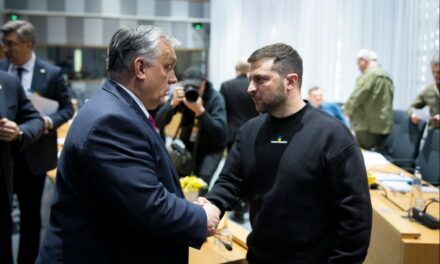The slave trade is a pan-European heritage, and Hungary has not been a democracy since the First World War. The European Parliament is trying to rewrite history in an interesting way.
Eastman Dental Hospital. An imposing, six-story art-deco "palace" in the Leopold park in Brussels, the Solvay library and building complex - and not by the way, next to the European quarter. This palace houses the museum and permanent exhibition with which the European Parliament wants to rewrite history.
Here is the House of European History.
The House opened its doors back in 2017, after ten years of renovation and preparatory work - and after the initial costs of the project had increased by more than 90 per cent, from £58 million to £112.5 million. The idea of the House was raised back in 2007 by Hans-Gert Pöttering, then President of the European Parliament. In his inauguration speech, Pöttering stated that "in national museums, European history is almost always presented from a purely national point of view. I would like to propose for history and the future a place where the concept of the European idea can continue to grow. I would like to propose the establishment of the 'House of European History'. This should not be a dry, boring museum, but a place where we jointly cherish the memory of European history and the work of European unification, and which is also available for European identity, so that current and future citizens of the European Union can further shape it. Such a 'House of European History' should be established at the headquarters of the European institutions".
The House of European History followed Pöttering's proposal. Maybe too much. He tries to foster European unification by creating a unified, pan-European historical canon, from which only the most important are left out:
the actual past and present of the member states that make up the EU.
The myth of Europe
The exhibition begins by highlighting the Asian heritage of Europeans: “Where does Europe begin and how long does it last? Since ancient times, Europe has been described as a separate entity, which was shaped by cultural and historical processes - however, geographically speaking, Europe and Asia are one continent", they write, and then continue to emphasize the heritage through the myth of Europe: "Europe, the mythical princess of Phoenicia - today's Lebanon - is abducted by Zeus , a Greek god who appears to her in the form of a white bull. After falling in love with her beauty, he takes her to the island of Crete. […] At the heart of the myth of Europe is the reality of the ancient relations – good and bad – between the peoples of Europe and the peoples of distant countries. The fact that Europe was actually named after a mythological princess from Western Asia is testimony to these connections.”
Remembrance is the basis of self-awareness, and the slave trade is a pan-European heritage
The exhibition discusses the importance of history as follows: "If we remember the past, can we avoid repeating its mistakes? Remembering is essential. Whether for individuals or social groups, it is the foundation of learning and self-awareness. However, memory is a complicated phenomenon. It is very selective and is inextricably linked to forgetting. Our memories are an integral part of history and define our present and future. How we remember the same story keeps changing.”
It's just that similar honey-glazed statements ring painfully empty in the light of the exhibition.
According to the exhibition, the following 14 points are capitalized European Heritage: 1. Philosophy. 2. Democracy. 3. Rule of law. 4. The presence of Christianity in all areas of life. 5. State terror. 6. Slave trade. 7. Colonization. 8. Humanism. 9. Enlightenment. 10. Revolutions. 11. Capitalism. 12. Marxism, communism and socialism. 13. The nation-state. 14. Genocide.
The exhibition presents the 14 heritages with 2 symbols chosen for their own purposes: the rule of law is illustrated with, for example, an alabaster statue from the 19th century, and an image of the arrest of a man protesting for gay rights (which, by the way, was somehow left out of the museum's official brochure).
To put it mildly, it is an interesting idea that the museum calls the slave trade and colonization a pan-European heritage, forgetting that Europe is a union of nations, so not all of its inhabitants include the slave-beating whip among the motifs of the past tucked under the delicate lace.
They wanted to write a pan-European history, but only history itself was left out
According to the permanent exhibition, practically nothing happened before the French Revolution, between 1789 and 1914 only technological revolutions were good, otherwise everyone became racist ("Abuses and inequalities were explained by the need to 'civilize' savages. The gradual abolition of slavery was intolerance and new forms of racism followed"), and between 1914 and 1945 Europe was in ruins, which is basically true during and after the two world wars, meanwhile the exhibition is spectacularly unable to reconcile the history of the various nations, so it rather generously glosses over them.
In the sense of the Union, internal political disputes and conflicts between nations are completely omitted from it.
They strive to pass on the pan-European history, but they do not see the forest from the trees - to put it better: in relation to the pan-European forest, they refuse to acknowledge that it consists of individual trees - the community of EU countries, with a different history in the image of each country, so the pan-European history is the totality of the history of each country. I mean, it just has to be.
According to the exhibition, for example, in 1920, authoritarian regimes emerged in only two places in Europe: Hungary and Russia. Of course, the first year of the Horthy era - despite universal suffrage - can be evaluated as authoritarian, but if we measure with the same standard, we see that the situation was similar in Poland, Yugoslavia and Romania, while in Italy and Germany, despite the formal democratic conditions, bloody battles took place on the street between the right-wing and communist free forces. And Finland was just recovering from a civil war that claimed 37,000 lives in those years. The message is clear: whoever we are not on good terms with right now has a dark past.
They made a similar comment about the years after the First World War: "After the First World War, there was democracy everywhere in Europe, with two exceptions: the Soviet Union, ruled by a one-party system, and Hungary, where democratic rights were restricted," they say in one of the videos.
The burning question of our time is the colonial legacy
The last "chapter" of the House of European History is about the burning questions of our time. In addition to climate change, wars and terrorism, Brexit, pandemics and the digital revolution were also listed here. In addition to all this, one "burning issue" stands out from the rest: the colonial heritage.
According to the exhibition, "objects with spiritual, religious, social or social meaning have become exhibition objects in European museums. Such appropriation and assimilation of African history, culture and traditions deprives objects of their original meaning and results in the loss of historical roots”. The exhibition does not report that such appropriation and assimilation of European history, culture and traditions deprives our history of its original meaning and results in the loss of our roots.
The Parlamentarium's interpretation of European history is similar
The Parlamentarium, which was created by the European Parliament and was keen on interactivity, also interpreted pan-European history in a similar way. Although, on the one hand, it nicely presents the differences of the EU apparatus in Brussels, Strasbourg and Luxembourg, on the other hand, the section of the exhibition concerning history is very similar to the House of European History: it presents our pan-European history as if there were famines and deep poverty in the states until the beginning of European integration. And of course, ever since the Union was born, Canaan rules here.
Featured image: Mandiner/Zsolt Mátyás Varga













